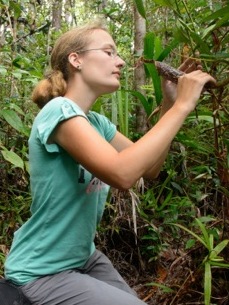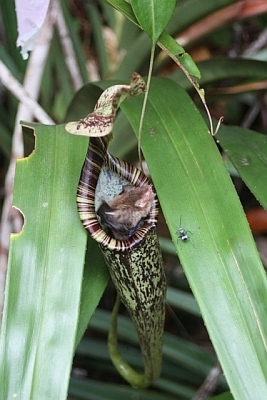
Dr. Caroline Regina Schöner
Applied Zoology and Nature Conservation
Loitzer Str. 26
17489 Greifswald
schoenerc(at)uni-greifswald(dot)de
Research Interests
Costs and Benefits in a Bat-Pitcher Plant Interaction
Despite ongoing researches, mutualisms still present a puzzle: How do they evolve? Which benefits overweigh the costs of all included partners? What keeps them alive? Which are the ultimate causes of mutualisms? To answer questions like these, I am researching on the interactions between bats and carnivorous pitcher plants (Nepenthes). In 2009, my colleagues and I discovered that the bat species Kerivoula hardwickii regularly roosts in the pitcher plant Nepenthes hemsleyana which absorbs nutrients from the bats’ feces. Further observations showed that the bats are also interacting with other pitcher plants but these pitchers do not gain nutrients and are less optimal as bat roosts (e.g. micro climate, parasite infestation or body condition of the bats). For a deeper knowledge about the ultimate causes of the bat-pitcher plant mutualism I experimentally feed pitcher plants in the field and the lab with alternative prey (insects/ bat feces) to analyze if there are feeding-correlated differences in growth rates, fluorescence and photosynthesis rates, chlorophyll contents or nitrogen/ phosphate uptake (e.g. by stable isotope analysis). Furthermore, I experimentally test the bats’ behavior towards different pitcher plant species and monitor their physiological reactions (e.g. body temperature). Additionally, I am conducting genetic analyses to find out if preferences in the choice of different pitcher plant species are based on genetic differences between populations or if they are a kind of tradition. Overall, this will improve our knowledge about mutualisms and the requirements of mutualistic species to their environment.

Relevant Publications
- Sagot, M., Schöner, C.R., Jago, A.J., Razik, I. & Chaverri, G. (2018): The importance of group vocal behaviour in roost finding. Animal Behaviour 142: 157-164.
- Schöner, M.G. & Schöner, C.R. (2018): Acoustic interactions between plants and animals. The Journal of the Acoustical Society of America 143: 1795-1795
- Schöner, M.G., Schöner, C.R., Ermisch, R., Puechmaille, S.J., Grafe, T.U., Tan, M.C. & Kerth, G. (2017): Stabilization of a bat-pitcher plant mutualism. Scientific Reports 7: 13170.
- Yilamujiang, A., Zhu, A., Ligabue-Braun, R., Bartram, S., Witte, C.-P., Hedrich, R., Hasabe, M., Schöner, C.R., Schöner, M.G., Kerth, G., Carlini & C.R., Mithöfer, A. (2017): Coprophagous features in carnivorous Nepenthes plants: a task for ureases. Scientific Reports 7: 11647.
- Unterseher, M., Karunarathna, S.C., Cruz, G.R., Dagamac, N.H., Dahl, M.B., Dool, S.E., Galla, M., Herbst, L., Nilsson, R.H., Puechmaille, S.J., Schöner, C.R., Schöner, M.G., Siddique, A.B., Teltewskoi, A., Wicke, K., Würth, D.G., Wurzbacher, C., Hyde, K.D. (2018): Mycobiomes of sympatric Amorphophallus albispathus and Camellia sinensis differ in diversity and composition and display clear tissue preferences. Mycological Progress dx.doi.org/10.1007/s11557-018-1375-8
- Schöner, M.G., Schöner, C.R., Kerth, G., Suhaini, S.N. & Grafe, T.U. (2017): Handle with care: Enlarged pads improve the ability of Hardwicke’s woolly bat, Kerivoula hardwickii (Chiroptera: Vespertilionidae), to roost in a carnivorous pitcher plant. Biological Journal of the Linnean Society 122: 643-650.
- Schöner, C.R., Schöner, M.G., Grafe, T.U., Clarke, C.M., Dombrowski, L., Tan, M.C. & Kerth, G. (2017): Ecological outsourcing: a pitcher plant benefits from transferring pre-digestion of prey to a bat mutualist. Journal of Ecology 105: 400-411.
- Schöner, M.G., Schöner, C.R., Kerth, G., Ji, L.L. & Grafe, T.U. (2016): Bats attend to plant structures to identify roosting sites. Acta Chiropterologica 18: 433-440.
- Schöner, M.G., Simon, R. & Schöner, C.R. (2016): Acoustic communication in plant - animal interactions. Current Opinion in Plant Biology 32: 88-95.
- Struebig, M.J., Huang, J.C.-C.H., Mohamed, N.Z., Noerfahmy, S., Schöner, C.R., Schöner, M.G. & Francis, C.M. (2016): Forest surveys extend the range of the Krau woolly bat (Kerivoula krauensis) in the Malay-Thai Peninsula, Borneo and Sumatra. Mammalia online early.
- Lim, Y. S., C. R. Schöner, M. G. Schöner, G. Kerth, D. G. Thornham, M. Scharmann & T. U. Grafe (2015): How a pitcher plant facilitates roosting of mutualistic woolly bats. Evolutionary Ecology Research 16: 581–591.
- Schöner, M. G., C. R. Schöner, R. Simon, T. U. Grafe, S. J. Puechmaille, L. L. Ji & G. Kerth (2015): Bats are acoustically attracted to mutualistic carnivorous plants. Current Biology 25: 1-6.
- Schöner, C. R., M. G. Schöner, G. Kerth, S. N. Suhaini & T. U. Grafe (2015): Low costs reinforce the mutualism between bats and pitcher plants. Zoologischer Anzeiger - A Journal of Comparative Zoology 258: 1-5.
- Schöner, C. R., M. G. Schöner, G. Kerth & T. U. Grafe (2013): Supply determines demand: Influence of partner quality and quantity on the interactions between bats and pitcher plants. Oecologia 173: 191-202x.
- Schöner, C. R. & M. G. Schöner (2013): Batty and Pitty. Children’s story. Illustrated by Claudia Spitzkopf and Robin Schöfer. Free download: www.seabcru.org/outreach/brunei-outreach-materials.
- Schöner, M. G. & C. R. Schöner (2013): Symbiotischer Untermieter gesucht. Hardwicke-Wollfledermäuse schlafen in fleischfressenden Pflanzen. Hundkatzepferd. Das Fachmagazin für den Tierarzt. 6: 2-4.
- Schöner, M. G. & C. R. Schöner (2012): Fledermausporträt: Hardwicke-Wollfledermaus, Kerivoula hardwickii (Horsefield, 1824). Nyctalus (N.F.) 17: 400-404.
- Schöner, C. R. & M. G. Schöner (2012): Living inside a deadly trap. Woolly bats use carnivorous pitcher plants as roosts. Bats 30 (3): 2-3.
- Grafe, T. U., C. R. Schöner, A. Junaidi, G. Kerth & M. G. Schöner (2011): A novel resource-service mutualism between bats and pitcher plants. Biology Letters 7: 436-439.
- Schöner, C. R., M. G. Schöner & G. Kerth (2010): Similar is not the same: Social calls of conspecifics are more effective in attracting wild bats to day roosts than those of other bat species. Behavioral Ecology and Sociobiology 46: 2053-2063.
Supervision
PhD projects
- Jésus Rafael Hernandez Montero (since 2016): "Associative learning in bats"
- Carolin Mundinger (since 2018): "Responses to changing environments in bats: Novel insights from long-term data"
Ongoing master and bachelor projects
- Julien Bota (since 2017): "Interactions between ants (Camponotus spp.) and the rattan palm Korthalsia robusta on Borneo (BSc)
- Julia Sophie Ellerbrock: "Influence of nutritions from bat feces in tropical ecosystems" (MSc.)
- Sofie Gawronski (since 2017): "Microbial effects on the performance of coprophagous pitcher plant species" (BSc)
- Johanna Lauffer (since 2017): "Does socialtiy influence the spatial memory of the foliage roosting bat Myotis muricola?" (BSc)
- Vanessa Ochlast (since 2017): "Do banana plants profit from the feces of foliage roosting bats?" (BSc)
- Jon A. Romero (since 2017): "Spatial memory of the solitarily foliage roosting bat Kerivoula hardwickii?" (MSc)
- Cristian Castillo Salazaar (since 2017): "Does bat personality and body condition predict access to high quality roosts?" (MSc)
- Lioba Ufer (since 2017): "Convergent microbial communities in the fluid of coprophagous pitcher plants" (BSc)
